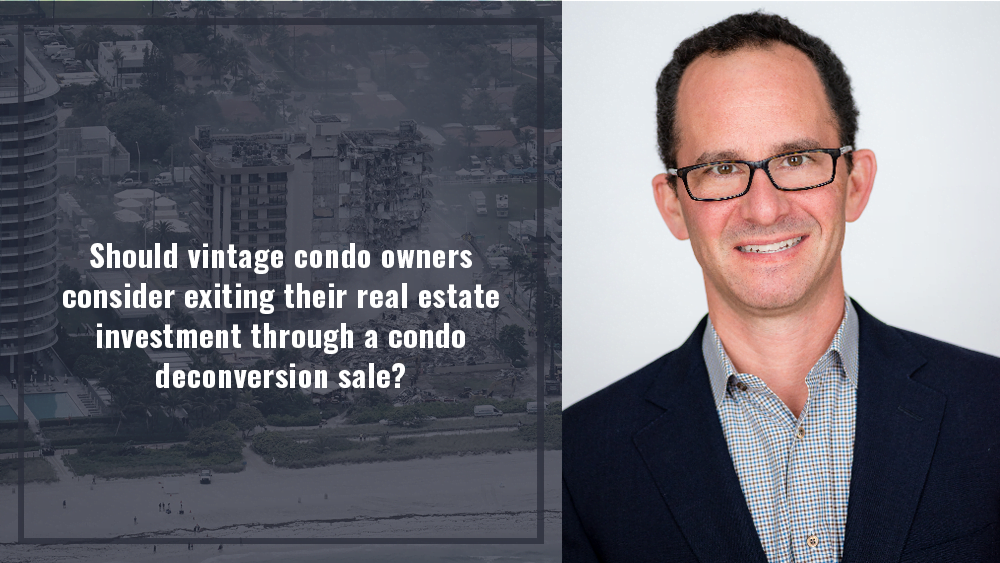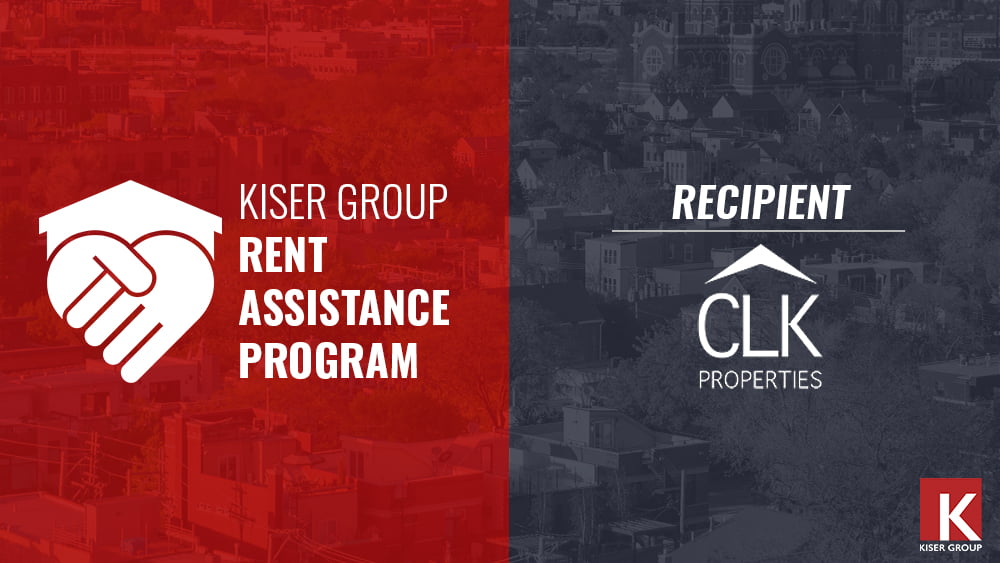08.04.21
In the wake of the Miami condo collapse, should vintage condo owners consider exiting their real estate investment through a condo deconversion sale?

We all saw the devastating news of the Surfside condominium collapse in Miami, Florida. This incident has left many condo owners wondering about the safety of their building and brought a spotlight to aging condo stock.
As a multifamily broker in Chicago, one of my specialties is condominium deconversion sales. In Illinois, it’s more formally called a Section-15 sale, which is a bulk sale of all of the units in a condominium to a single investor that plans to turn all of the units into apartments. For the past few years, this type of real estate transaction has picked up momentum in Chicago and other markets.
Why would a building deconvert?
- Deferred Maintenance – As condominium buildings age, they are more likely to get behind on necessary maintenance. From elevator replacements to facade repairs, HOA fees experience year over year growth and special assessments begin to happen more and more frequently. This puts owners in a scenario where they can be unable and even unwilling to pay for necessary work. Multiple units then go on the market for sale and find few willing buyers and only at discounted pricing.
- Financially Driven Deconversion – The most common property type that deconverts in Chicago is a property that was converted from apartments to condos before the recession. These “starter condos” sold for high pricing during the housing boom, only to see their values disintegrate after the crash. For a unit owner that needed to move, their choice was to either sell at a steep loss or to keep the unit and rent it out. Most owners chose the latter, and became what we term an “accidental landlord”. It is now common to see condominium buildings where half or more of the units are used as rentals, which then impairs the resale value of all units in those buildings. A deconversion is the only way for owners to get their units sold at prices that resemble pre-2008 numbers.
- Bulk Owner Deconversion – There are also instances where one person may own a large chunk of units in a building and drive the deconversion process. Typically these bulk owners are either the original condo developer that got stuck with unsold units when the recession happened, or the people that purchased unsold units when the developer went bankrupt. When someone owns a large number of units, deconversion is the best way for them to exit. Selling units individually can take years and will depress pricing by its own nature. There are investors who will buy these chunks, but they will discount pricing compared to what they believe the entire building is worth.
What types of buildings are the best fit for deconversions?
Almost all buildings in Chicagoland that deconvert were built as apartments and then converted to condominiums in the ’90s and ’00s.
- Vintage buildings (pre-1929). Vintage buildings make up the bulk of the housing stock in Chicago. Built in a time when labor and material pricing allowed for much sturdier construction, local landlords love to own these buildings. They do require constant upkeep, which is routine for apartment building owners but difficult to stay on top of for condominium boards.
- Mid-century high-rises. These buildings are the most susceptible to crushing special assessments. As these buildings age, their galvanized plumbing degrades to the point where it must be replaced with copper. Facades lose their integrity, elevator systems become outdated, and full-building window replacements can be necessary. These items are not only prohibitively expensive but also disruptive to daily life inside the building.
- Mid-century garden complexes. These suburban properties are less frequently deconverted. Maintenance needs tend to be less severe than in high rises, but more importantly, it can be much harder for owners to find a nearby replacement property than for city owners. As these complexes can contain hundreds of units and investors have turned focus to the suburbs post-pandemic, I expect to see more of these.
Why would someone buy a condo deconversion?
Multifamily investors or apartment investors see condo deconversions as an appealing real estate investment for a number of reasons. In major metros like Chicago, the market for multifamily properties remains strong, especially for value-add properties. In certain sought-after neighborhoods, the ability to acquire properties can be near impossible in the first place as owners rarely sell their buildings. Deconversions create new inventory for sale.
What is the condo deconversion process like for condo owners?
The most important first step for an association is to engage an experienced broker and an experienced attorney to guide them through the process. Deconversions entail much more than simply finding a buyer to buy the property. There are many practical and legal hurdles that must be overcome to get all the way to a successful close.
What should an association exploring a sale ask a broker?
- How much is the building worth if put on the market? – Discover what the price of the building, as a whole, is worth through a Broker Opinion of Value or Sale Analysis. Both of these are industry-speak for having a broker underwrite the value of the building based on their market expertise. Without this guidance, the association has no true frame of reference as to what the building is actually worth. While the market itself is the ultimate arbiter of value, it is important that an association have realistic expectations for a sale.
- Discuss the physical condition of the building and ask how it will impact a sale – Investors will factor necessary maintenance spend into their offer prices. A full understanding of immediate and future needs is a key component to both the opinion of value and the marketing process.
- How can an association maximize the likelihood of closing in the least amount of time, without being taken advantage of? – Hiring an experienced broker to run an open and competitive marketing process produces multiple offers for a property. Boards then work with brokers to discuss and negotiate non-price terms such as length of due diligence and owner lease-back rates. Having back-up offers also puts buyers on their best behavior as they know they can be replaced.
- What are the chances of a successful vote in a sale at our property? – While it is impossible in all but the smallest of condominium buildings to know ahead of time how every owner will vote on a sale, it is important that the board have a good idea of where its ownership stands. Owners must be educated on what pricing to expect and what each part of the process entails. With proper communication, a board should have a good idea of the association’s stance and can make a decision on whether or not to pursue a sale.
- How do we allocate the sale proceeds across individual units? Most importantly, how can this process be handled in an orderly and professional manner that holds the owners’ interests first? In a deconversion sale, a buyer does not make offers on each unit- they offer one price for the entire property. The most common method of price allocation to owners is to allocate according to each unit’s ownership in the association, as shown in its condominium declaration. This method is 100% objective and is the best choice for most properties. Some offers have extra money for units that have meaningful upgrades, a process that can be tedious to work through and introduces subjectivity to the process. In properties where allocation by ownership percentage results in highly disparate outcomes for different unit owners, a custom allocation can be made to help equalize benefits.
If the answers to the above questions are appealing for the condo owners, then it’s time to select a broker and put the building on the market.
What happens when the condo building is put on the market for sale?
The selected broker will leverage its extensive relationships with local Chicago apartment building owners, condo deconversion investors and institutional real estate investors across the country to generate property tours and subsequent offers. Having multiple bidders ensures that an association receives maximum value and best terms for their property.
The broker will then present every offer to the association and counsel the association on the merits of each including financial capabilities and history of behavior in past transactions. Follow-on negotiations then finalize the choice of buyer.
Once the association chooses the most acceptable offer, the broker alongside legal representation leads the association through the process from buyer acceptance, to voting, through escrow, and finally to deal closing. There are vulnerabilities to the deal in each of these steps, and each individual deal always produces its own unique challenges to overcome. Without experienced representation, these challenges delay and/or kill deals.
My team specializes in condominium deconversions and has guided associations from start to finish in buildings of all sizes and locations. If you are curious to learn more about condo deconversions or are part of a condominium association, please reach out at afriedman@kisergroup.com.
